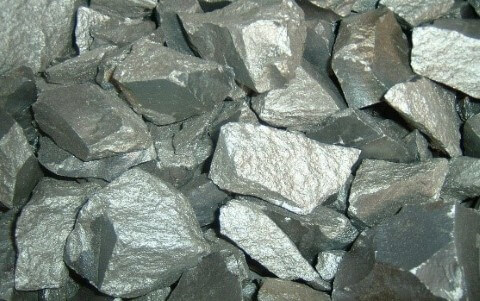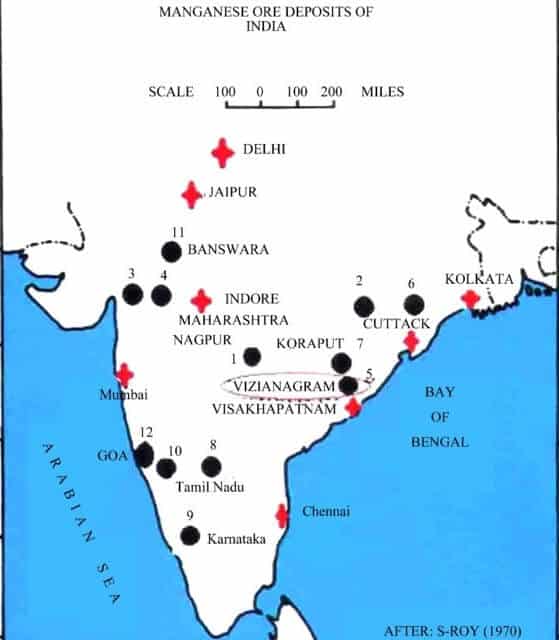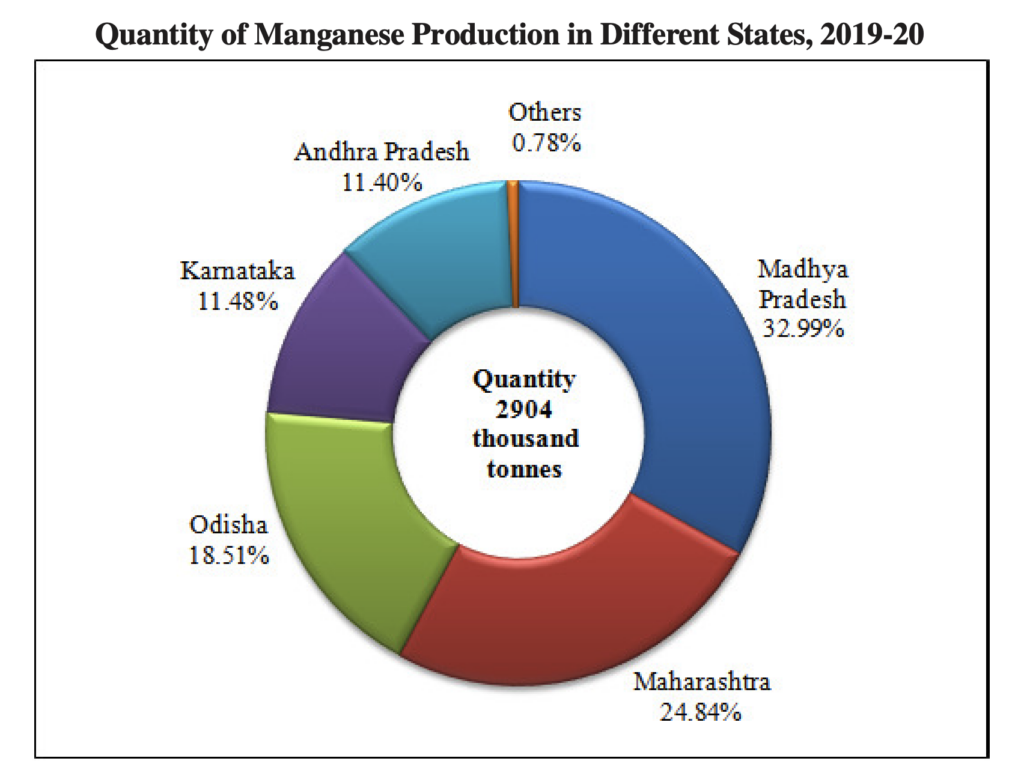Manganese
- Manganese occurs as silvery grey in colour and is very hard and brittle in nature.
- Manganese reserve in India is quite satisfactory. Like iron ore, manganese ores are also abundant in the Dharwar and Kuddapa series of the Pre-Cambrian era.
- Manganese is not found as a free element in nature. It is often found in combination with iron, laterite and other minerals.
- The most important manganese ore is pyrolusite.
- Manganese is primarily used in the iron and steel industry. It is the basic raw material for manufacturing steel alloys.
- 6 kilograms of manganese ore is required for manufacturing one tonne of steel.
- It is also used in the manufacturing of bleaching powder, insecticides, paints, and batteries.
- Manganese ores of major commercial importance are: (i) pyrolusite (MnO2, Mn about 63.2%); (ii) psilomelane (manganese oxide, containing water and varying amounts of oxides of Ba, K and Na as impurities; Mn commonly 45–60%); (iii) manganite (Mn2O3H2O, Mn about 62.4%); and (iv) braunite (3Mn2O3, MnSiO8, Mn about 62% and SiO2 about 10%).

Manganese Ore Distribution in India
- India processes second largest reserves in the world after Zimbabwe; 430 million tonnes
- India is the world’s fifth-largest producer after China, Gabon, South Africa, and Australia.
- Maharashtra, Madhya Pradesh, Odisha, Andhra Pradesh, and Karnataka are the major manganese ore-producing states.
- Maharashtra and Madhya Pradesh together produce more than half of India’s manganese.
- Indian manganese ore deposits occur mainly as
- metamorphosed bedded sedimentary deposits associated with Gondite Series (Archaeans) of Madhya Pradesh (Balaghat, Chhindwara & Jhabua districts), Maharashtra (Bhandara & Nagpur districts), Gujarat (Panchmahal district), Odisha (Sundargarh district),
- and with Kodurite Series (Archaeans) of Odisha (Ganjam & Koraput districts) and Andhra Pradesh (Srikakulam & Visakhapatnam districts).

Manganese Ore Distribution: State-wise reserves of Manganese
- The total reserves/resources of manganese ore in the country as on 2015 has been placed at 495.87 million tonnes as per NMI database, based on UNFC system.
- Out of these, 93.47 million tonnes are categorised as Reserves and the balance 402.40 million tonnes are in the Remaining Resources category.
- Gradewise, Ferromanganese grade accounts for 7%, Medium grade 11%, BF grade 28% and the remaining 54% are of Mixed, Low, Others, Unclassified, and Not-known grades including 0.17 million tonnes of Battery/Chemical grade.
- Statewise, Odisha tops the total reserves/ resources with 44% share followed by
- Karnataka (22%),
- Madhya Pradesh (12%),
- Maharashtra & Goa (7%) each,
- Andhra Pradesh (4%) and
- Jharkhand (2%).
- Rajasthan, Gujarat, Telangana and West Bengal together shared the remaining 2% resources.
- Madhya Pradesh is the leading producing State of manganese ore accounting for 33% of total production during 2019-20 followed by Maharashtra 25% and Odisha 19%.


Madhya Pradesh
- Produces about 33 percent of India’s manganese ore.
- The main belt extends in Balaghat and Chhindwara districts.
- It is just an extension of the Nagpur Bhandara belt of Maharashtra.
Maharashtra
- Produces about 25.25 percent of Indian manganese.
- The main belt is in Nagpur and Bhandara districts.
- High-grade ore is found in the Ratnagiri district also.
Odisha
- Orissa is one of the largest producers of this mineral, here it is found in Sundergarh district and Keonjhar district mainly. (Previously Keonjhar district alone produced 1/4th of the total production of the country).
- Still, Odisha produces 24% of the country’s production. Apart from there, two districts Kalahandi and Koraput Districts are also important producers of manganese.
Karnataka
- About 10.92 percent of India’s manganese.
- Uttara Kannada, Shimoga, Bellary, Chitradurga, and Tumkur districts.
Andhra Pradesh
- About 9.71 of India’s manganese production.
- Srikakulam and Vishakhapatnam districts.
- Srikakulam district has the distinction of being the earliest producer (1892) of manganese ore in India.
- Cuddapah, Vijayanagaram, and Guntur are other manganese-producing districts.
Other producers
- Goa,
- Panchmahals and Vadodara in Gujarat,
- Udaipur and Banswara in Rajasthan and
- Singhbhum and Dhanbad districts in Jharkhand are other producers of manganese.
Export of Manganese
- Four-fifths of the total production is consumed domestically.
- Exports constantly decreasing due to increasing domestic demand.
- Japan is the largest buyer of Indian manganese.
- The other buyers are the USA, UK, Germany, France, Norway.
Uses of Manganese
- Manganese is used in rifle barrels, railway tracks, safes, and prison bars.
- Manganese is used in the production of steel.
- Manganese is used in the production of a variety of important alloys and to deoxidise steel and desulfurise.
- Manganese is used in dry-cell batteries.
- Manganese is used as a black-brown pigment in paint.
- Manganese is also used as a catalyst to decolourise glass.
- Manganese sulfate is used to make a fungicide and other pesticides.
Worldwide Supply of and Demand for Manganese
- Only four countries produced 70% of the world’s manganese ore in 2011, in decreasing order of production: South Africa, Australia, China, and Gabon.
- These four countries, plus Brazil and Ukraine, account for 90% of proven manganese reserves.
- The United States, like many other industrialized countries, particularly in Europe, has no manganese reserves.
- In the United States, all manganese ore is imported. Gabon (61%) was the primary source of ore from 2008 to 2011, followed by Australia (21%), South Africa (7%), and Brazil (5 percent).
- Manganese demand has historically tracked steel production and is expected to do so again in the future.

Thank you so much 🙌
Thankyou so much !
Thanks sir
truly amazing notes , hats of to your hardworking commitment
great notes